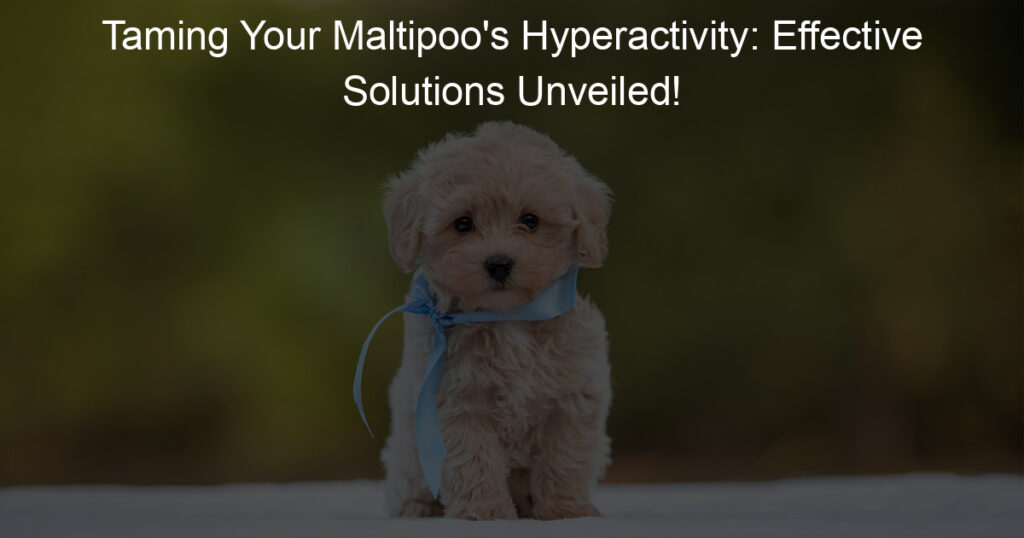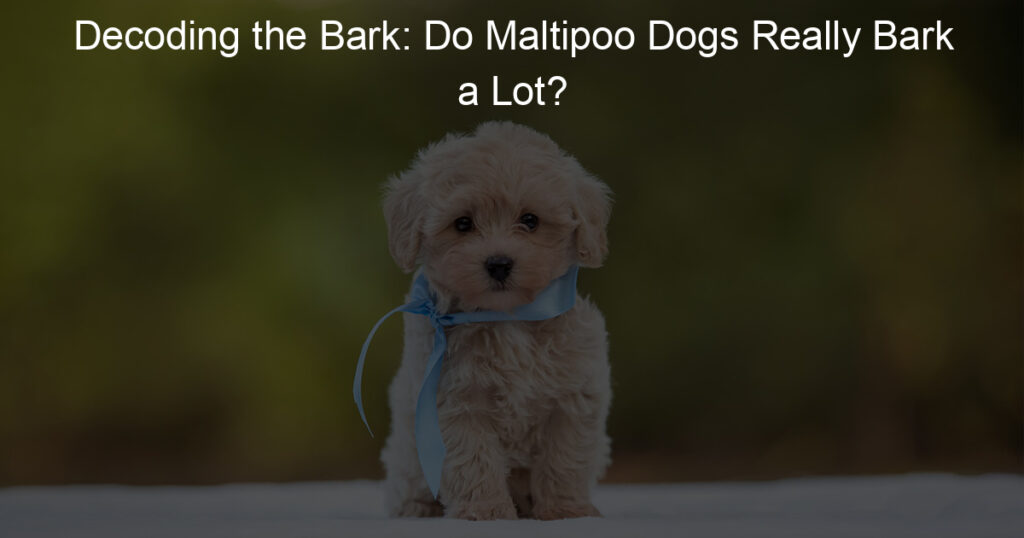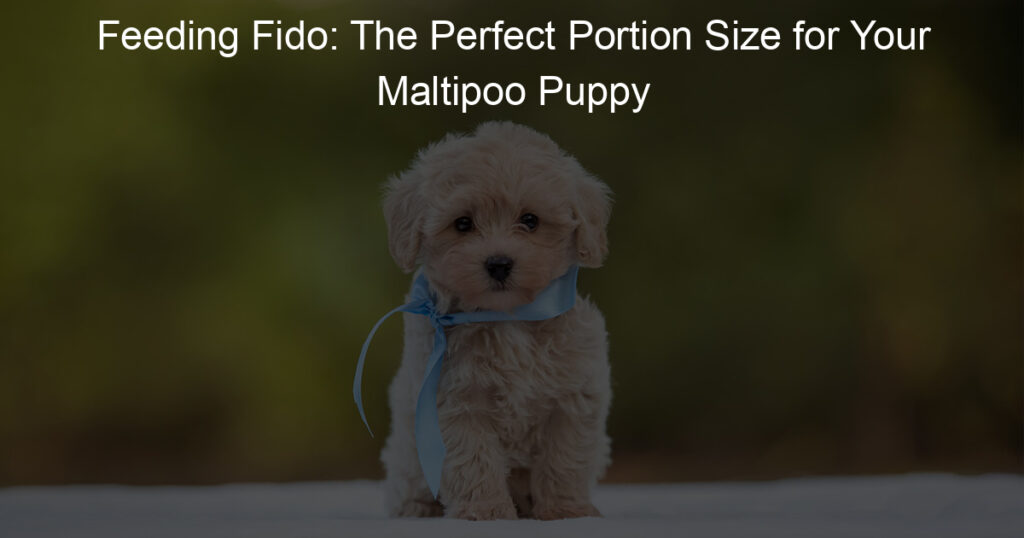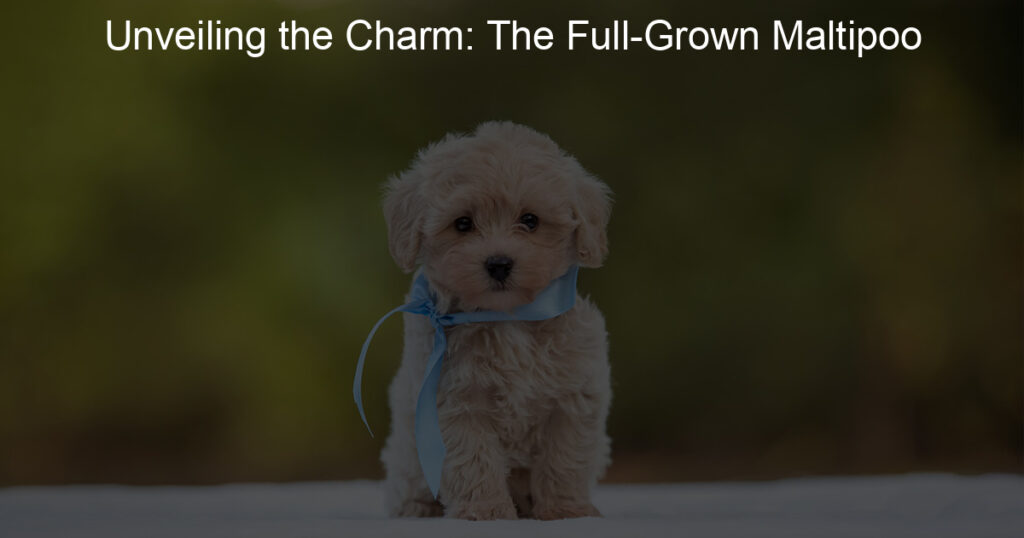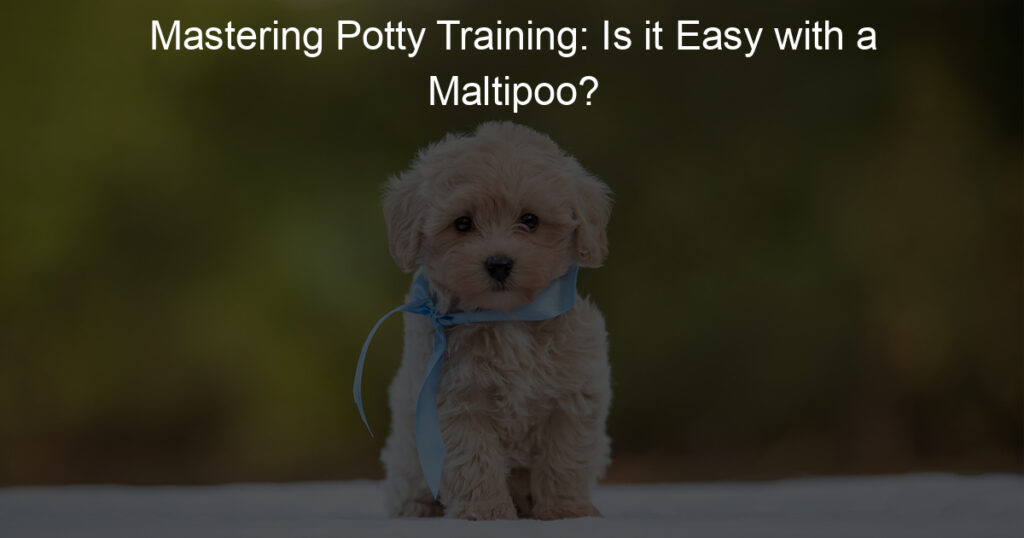
Understanding Maltipoo Behavior
When it comes to understanding Maltipoo behavior, it’s essential to know that these dogs are a mix of Maltese and Poodle breeds. As a result, they inherit traits from both parents, making them unique and charming pets. In this section, we’ll delve into the characteristics of a Maltipoo, common behavior problems, and how to understand hyperactivity in Maltipoos.
- Characteristics of a Maltipoo
- Common Maltipoo behavior problems
- Understanding hyperactivity in Maltipoos
Maltipoos are known for their friendly and affectionate nature. They are intelligent dogs, which makes them easy to train. However, their intelligence also means they require mental stimulation to prevent boredom. Maltipoos are sociable and love being around their human family. They are also known to be quite vocal, often barking to alert their owners of any perceived danger or when they are bored or anxious.
Despite their charming nature, Maltipoos can exhibit certain behavior problems. These include excessive barking, separation anxiety, and stubbornness. Excessive barking usually occurs when the dog is bored or anxious. Separation anxiety is common in Maltipoos because they form strong bonds with their owners and can feel distressed when left alone. Stubbornness can be a result of the dog’s intelligence; if not properly stimulated, they can resist training or commands.
Hyperactivity in Maltipoos is often a result of excess energy that has not been properly expended. This can manifest in behaviors such as excessive barking, jumping on people, or chewing on furniture. It’s important to note that hyperactivity can also be a sign of anxiety or a lack of mental stimulation. Therefore, providing your Maltipoo with regular exercise and mental challenges can help manage this behavior.
In the following sections, we’ll explore how to identify a hyperactive Maltipoo, how to manage this hyperactivity through training, and how to meet the exercise needs of your Maltipoo. We’ll also share some case studies of dealing with hyperactive Maltipoos and key takeaways for Maltipoo behavior solutions.
Identifying a Hyperactive Maltipoo
Hyperactivity in Maltipoos is a common issue that many pet owners face. It’s important to understand the signs, causes, and impacts of this behavior to ensure your furry friend’s overall well-being. Let’s delve into these aspects.
- Signs of a Hyperactive Maltipoo
- Causes of Hyperactivity in Maltipoos
- Impact of Hyperactivity on Maltipoo’s Health and Behavior
A hyperactive Maltipoo will exhibit excessive energy levels, often running around, barking, and jumping more than usual. They may also have difficulty focusing and might struggle with basic commands. In some cases, they might show signs of anxiety, like excessive chewing or scratching.
Hyperactivity in Maltipoos can be caused by a variety of factors. These may include lack of exercise, poor diet, lack of mental stimulation, or even underlying health issues. It’s also worth noting that some Maltipoos may naturally have higher energy levels than others.
Hyperactivity can have a significant impact on a Maltipoo’s health and behavior. It can lead to destructive behaviors, like chewing on furniture or digging in the yard. It can also cause stress, which can lead to health issues like digestive problems or skin conditions. Furthermore, it can impact their social behavior, making them more aggressive or anxious around other dogs or people.
In conclusion, identifying and addressing hyperactivity in your Maltipoo is crucial for their health and happiness. By understanding the signs, causes, and impacts, you can take steps to manage this behavior effectively. Stay tuned for our next section where we’ll discuss strategies for managing hyperactivity in Maltipoos.
Maltipoo Training: Managing Hyperactivity
Training your Maltipoo to manage hyperactivity can be a challenging task, but with the right techniques and a little patience, it can be done successfully. Let’s delve into the basics of Maltipoo training.
Basic Maltipoo Training
Before we dive into the specifics of managing hyperactivity, it’s crucial to understand the basics of Maltipoo training. Here are two key aspects to consider:
- Importance of Early Training
- Effective Training Techniques for Maltipoos
Early training is crucial for all dogs, and Maltipoos are no exception. The earlier you start training your Maltipoo, the easier it will be to manage their behavior as they grow. Early training helps in establishing rules and setting boundaries, which can significantly reduce hyperactive behavior.
Maltipoos are intelligent and eager to please, making them relatively easy to train. However, they can also be stubborn at times, so it’s important to use effective training techniques. Positive reinforcement, such as treats and praises, works well with Maltipoos. Remember, consistency is key. It’s also important to keep training sessions short and fun to keep your Maltipoo’s attention.
Understanding these basic principles can make a significant difference in your Maltipoo’s behavior and your ability to manage their hyperactivity. Remember, patience and consistency are key in any training regimen.
Specialized Training for Hyperactive Maltipoos
Training a hyperactive Maltipoo can be a challenge. However, with the right strategies, it can be a rewarding experience. Let’s explore some specialized training techniques that can help manage hyperactivity in Maltipoos.
- Behavioral Modification Techniques
- Professional Help: When and Why?
Behavioral modification techniques are a cornerstone of training for hyperactive Maltipoos. These techniques aim to change the dog’s behavior by rewarding good behavior and discouraging bad behavior. For example, if your Maltipoo is jumping around excessively, you can teach it to sit or lie down instead. Reward your dog with treats or praise when it follows your command. This positive reinforcement encourages your Maltipoo to repeat the good behavior.
Another effective technique is the “time-out” method. If your Maltipoo is too hyperactive, remove it from the stimulating environment for a few minutes. This helps your dog to calm down and understand that hyperactivity leads to isolation.
While many owners can successfully train their hyperactive Maltipoos, sometimes professional help is needed. If your dog’s hyperactivity is causing significant problems, or if your training efforts are not working, it may be time to seek professional help.
A professional dog trainer or a canine behaviorist has the knowledge and experience to handle hyperactive dogs. They can provide personalized training plans and techniques that are tailored to your Maltipoo’s specific needs. Additionally, they can help identify any underlying issues that may be causing the hyperactivity, such as anxiety or medical conditions.
In conclusion, managing a hyperactive Maltipoo requires patience, consistency, and the right techniques. Whether you choose to train your dog yourself or seek professional help, remember that every Maltipoo is unique and what works for one might not work for another. Therefore, it’s important to be flexible and adjust your training approach as needed.
Calming Hyperactive Dogs: Maltipoo Edition
Managing a hyperactive Maltipoo can be a challenge, but with the right strategies, it’s entirely possible. Here are some key methods to help calm your energetic Maltipoo.
- Creating a Calm Environment
- Use of Calming Aids and Toys
- Role of Diet in Managing Maltipoo Energy
One of the most effective ways to calm a hyperactive Maltipoo is by creating a calm, peaceful environment. This includes reducing loud noises, keeping the temperature comfortable, and providing plenty of soft, cozy places for your dog to rest. It’s also beneficial to establish a regular routine, as predictability can help reduce anxiety and hyperactivity.
Calming aids such as anxiety wraps or calming collars can be very effective in managing hyperactivity. These products work by applying gentle, constant pressure, which can have a soothing effect on dogs. Additionally, toys that stimulate your Maltipoo’s mind can help burn off excess energy. Puzzle toys or toys that dispense treats can keep your dog engaged and help reduce hyperactivity.
The diet you provide for your Maltipoo can significantly impact their energy levels. Foods high in protein and complex carbohydrates can provide sustained energy, while foods high in sugar can lead to spikes and crashes in energy levels. It’s also important to feed your Maltipoo at regular intervals to maintain stable energy levels throughout the day.
In conclusion, calming a hyperactive Maltipoo involves creating a calm environment, using calming aids and toys, and managing their diet. By implementing these strategies, you can help your Maltipoo lead a happier, more relaxed life.
Maltipoo Exercise Needs
Just like humans, Maltipoos need regular exercise to stay healthy and happy. This section will help you understand your Maltipoo’s exercise needs, suggest effective exercises for a hyperactive Maltipoo, and explain the impact of regular exercise on Maltipoo behavior.
- Understanding Maltipoo’s exercise needs
- Effective exercises for a hyperactive Maltipoo
- Fetch: This game not only helps burn off energy but also stimulates their mind.
- Tug of War: A great indoor game that can tire out your Maltipoo.
- Hide and Seek: This game helps to work their brain as they try to find you.
- Agility Training: Setting up an agility course in your backyard can provide a great workout for your Maltipoo.
- Impact of regular exercise on Maltipoo behavior
Maltipoos are a crossbreed of Maltese and Poodle, inheriting the energy and intelligence from both breeds. They require about 30 to 60 minutes of exercise daily. This can be divided into two or three walks, along with some playtime. Regular exercise helps to keep your Maltipoo physically fit and mentally stimulated. Remember, a tired Maltipoo is a happy Maltipoo!
If your Maltipoo is hyperactive, they might need more exercise than the average Maltipoo. Here are some effective exercises:
Regular exercise has a significant impact on your Maltipoo’s behavior. It helps to reduce hyperactivity, anxiety, and destructive behaviors. Exercise stimulates the production of serotonin, a hormone that helps to improve mood and promote a sense of calmness. Additionally, regular exercise can help to strengthen the bond between you and your Maltipoo.
In conclusion, understanding and meeting your Maltipoo’s exercise needs is crucial for their overall well-being. Not only does it help to manage hyperactivity, but it also contributes to their physical health and emotional happiness.
Dealing with Hyperactive Maltipoo: Case Studies
Let’s take a look at some real-life examples of how hyperactive Maltipoos have been successfully managed. These case studies will provide you with practical insights and strategies that you can apply with your own furry friend.
- Case Study 1: Taming a Hyperactive Maltipoo with Training
- Case Study 2: Managing Maltipoo Energy with Diet and Exercise
- Case Study 3: Successful Use of Professional Help in Calming Hyperactive Dogs
Meet Bella, a one-year-old Maltipoo who was always on the go. Her owners, the Johnson family, were at their wits’ end. They decided to try a structured training program, focusing on obedience and behavior modification. After a few weeks of consistent training, Bella began to show signs of improvement. She was more attentive, less destructive, and her hyperactivity levels significantly decreased. The Johnsons learned that consistency and patience were key in training Bella.
Next, we have Max, a two-year-old Maltipoo with boundless energy. His owner, Mrs. Smith, noticed that Max was more hyperactive than other dogs of the same breed. After consulting with a vet, she decided to adjust Max’s diet and increase his exercise routine. Max was put on a high-protein diet to support his high energy levels, and his daily walks were increased from 30 minutes to an hour. Over time, Max’s hyperactivity decreased, and he became more manageable at home.
Finally, we have Daisy, a three-year-old Maltipoo who was extremely hyperactive. Her owners, the Martinez family, tried various methods to calm her down but to no avail. They decided to seek professional help and hired a dog behaviorist. The behaviorist worked with Daisy, using a combination of training techniques and behavior modification strategies. After several sessions, Daisy’s hyperactivity decreased significantly. The Martinez family learned the importance of seeking professional help when needed.
These case studies highlight that dealing with a hyperactive Maltipoo requires patience, consistency, and sometimes, professional help. Remember, every dog is unique and what works for one might not work for another. It’s all about finding the right balance and approach for your Maltipoo.
Key Takeaways: Maltipoo Behavior Solutions
- Understanding your Maltipoo’s behavior: Maltipoos are a crossbreed of Maltese and Poodles, inheriting the intelligence and energy of both breeds. They are known for their playful and friendly nature. Understanding your Maltipoo’s behavior is the first step to managing any behavioral issues. They may exhibit behaviors like excessive barking, chewing, or hyperactivity due to boredom, lack of exercise, or anxiety.
- Identifying and managing hyperactivity: Hyperactivity in Maltipoos can manifest as excessive jumping, barking, or chewing. It’s important to identify these signs early and take steps to manage them. This can be done through regular exercise, mental stimulation, and consistent training. Remember, a tired Maltipoo is a well-behaved Maltipoo.
- Importance of training and exercise: Training and exercise are crucial for a healthy and well-behaved Maltipoo. Regular exercise helps burn off excess energy and reduces hyperactivity. Training, on the other hand, provides mental stimulation and helps establish boundaries. A well-exercised and trained Maltipoo is less likely to exhibit problematic behaviors.
- Role of diet and environment in calming hyperactive dogs: A balanced diet and a calm environment can significantly contribute to calming a hyperactive Maltipoo. Foods rich in proteins and complex carbohydrates can help maintain steady energy levels, while a calm and quiet environment can reduce anxiety and restlessness. Consider incorporating calming activities like gentle petting or soft music into your Maltipoo’s routine.
In conclusion, understanding your Maltipoo’s behavior, identifying and managing hyperactivity, and emphasizing the importance of training, exercise, diet, and environment are key to addressing behavioral issues in Maltipoos. With patience, consistency, and love, you can help your Maltipoo become a well-behaved and happy member of your family.

